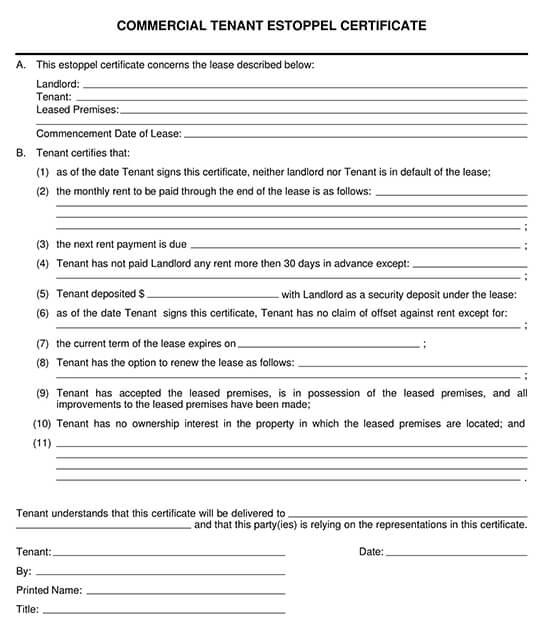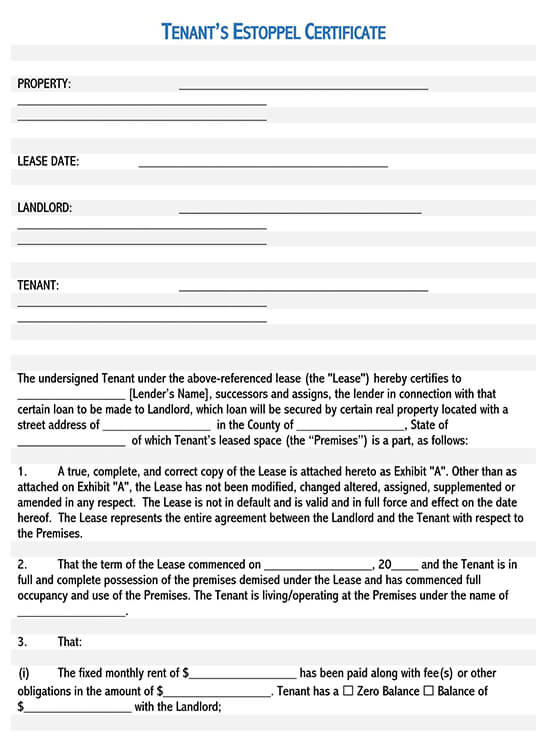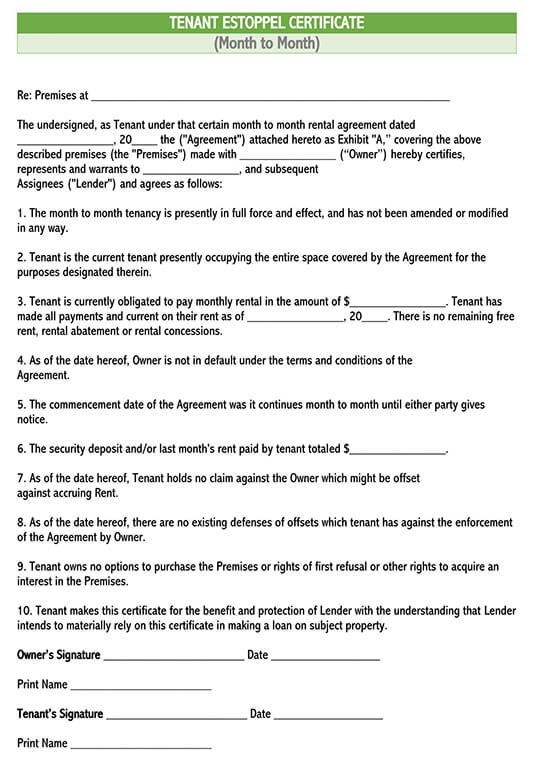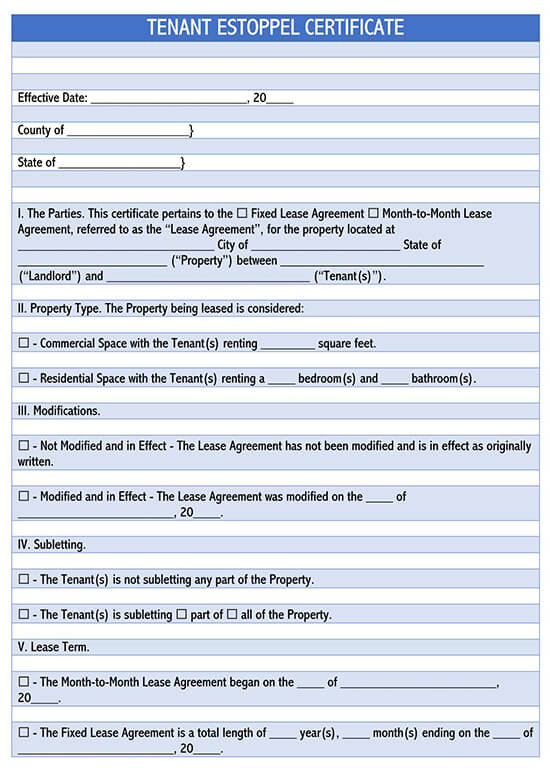When renting a property, you may receive something from your landlord called a Tenant Estoppel Certificate. The term Estop simply means “to stop or prevent.” Estoppel is a principle in law that works to stop a person from contradicting something they previously stated. It works to protect people from any inconsistencies in another person’s words.
What is a Tenant Estoppel Certificate?
A Tenant Estoppel Certificate is a document that is used in real estate that confirms current lease details between a tenant and landlord, as well as the relationship between the two. It states that all of the agreements’ facts are true, and both the tenant and landlord are required to sign the certificate. It can also detail the rights of the tenant and works to give accurate facts about the lease. It’s a document that is typically required by a lender before deciding to lend money for commercial and residential property.
It must include the following details:
- The lease start and end date
- The amount of rent that is paid monthly
- Copies of rent payments from the past three months (to prove there is actually a tenant)
- Signature of the tenant (must be notarized)
Basically, an estoppel certificate lets tenants deny or confirm the information that the landlord has provided to a lender or third party buyer. These documents tend to be nor more than a page or two and should be written clearly so that there is no confusion regarding what the landlord is reporting.
Free Forms






What to Include
The wording of a Tenant Estoppel letter will vary, but they should include these key points:
- The start date of the lease.
- The date that rent is paid.
- Should state whether there are any defaults by either the landlord or the tenant. If there are, then details of the defaults must be specified.
- It should verify that the lease is still in effect and that it has not been modified. If there have been modifications, a statement must be included that verifies the modifications.
How to Obtain a Tenant Estoppel Certificate
An estoppel certificate must be signed by a tenant in the presence of a legitimate notary public. The form is usually filled out by the landlord and their real estate agent.
Original lease
The first step is to obtain the original lease agreement that was signed by the tenant.
The details that you will need from the lease are:
- The amount of rent paid monthly
- Expenses that both the tenant and landlord are responsible for
- The start and end dates of the lease
- Whether the tenant has the right to sublet the property
- How much of a security deposit was made
- Any rent pre-payments that the tenant has made
Tenant behavior
In this section, you will need to report if the tenant has been served an eviction notice. You will need to provide copies of the notice to attach to the estoppel certificate.
Proof of previous rent
Lenders will require proof that there is actually a tenant that is making monthly payments for rent. This can be provided by receipt and checks and must include at least the last 3 months’ payments.
Tenants signature
Once you have established all of the facts regarding the lease details are correct, you will need the tenant to sign the estoppel. This must be done in front of a notary public in order to prove that it was the tenant who authorized the estoppel form. They will need to prove their identity with valid identification that is government-issued.
How to Write a Tenant Estoppel Certificate
When you have the original lease and all of the documentation required, you can begin filling in the details for the estoppel certificate.
Details about the lease, property, and parties involved
Your first step is to give the date that you are preparing the document. You will need to give details about the lease, such as whether it is a fixed or month to month agreement. You will then need to give the full address of the property being leased, including any unit numbers. Lastly, give the full name of both the landlord and the tenant.
Relevant agreements
In this section, details regarding whether the lease has been modified or sublet, along with relevant dates and details must be given. The tenant must also indicate if the lease is still active.
Lease details
Next, the details of the lease will be needed:
- Whether the lease is a fixed-term or month to month agreement, give the date that the lease agreement commenced, how long the agreement is in effect for, and what the termination date of the lease is.
- Payment details – give the exact amount paid and how often
- Additional fees – enter any fees, aside from the rent, that the tenant pays and what they are for.
- Give the full date of the last rental payment made, as well as any rent payments that were made in advance. Also include the amounts for each.
- Security deposit – give the full amount paid by the tenant
Provisions
The next part of the estoppel certificate details any provisions that need to be met, such as:
- Whether the landlord has any personal property at the address of the leased property, details must be given of what this is and whether the tenant has possession of it.
- Whether the tenant has been given the right to purchase the property being leased
- Whether there are any pending repair issues that need to be addressed and whether the landlord maintains the property well
- Whether there have been any violations to the lease agreement and whether or not these have been corrected. Full details must be given.
Signature
The last part of the certificate will be where the tenant must sign and date the document in the presence of a notary public. The tenant should only sign if they agree with all that has been detailed in the document.
When a Tenant Estoppel Certificate is Needed
The document serves as a promise to lenders or potential buyers that supports the claims made by the landlord regarding the lease and rental income/cash flow. It protects the lender from any future financial surprises, such as tenant refusing to pay rent because the landlord hasn’t made promised repairs. The lender can then review the estoppel certificate signed by the tenant to see if there was a mention of these needed repairs. If there wasn’t, the tenant would not have the right to withhold their rent.
What a Tenant Estoppel Certificate Protects
The estoppel certificate works to protect landlords, tenants, and potential buyers. If a person is trying to purchase a property from your landlord, they will want to ensure that there are no issues with the lease agreement that could potentially cost them later on. For landlords, it protects them from a tenant making a false claim that could cost the landlord, such as having them state they pay a much lower rent than they actually do.
It also works to protect tenants if a landlord has not rectified a complaint. For example, if the landlord has not maintained some part of the property and the tenant has lodged a legal complaint. The estoppel makes sure that the buyer is aware of the issue, and agrees to take it on, or refuses to buy the property until the landlord has rectified the issue.
Frequently Asked Questions
An estoppel certificate may be created by a landlord or their agent but must be completed and signed by the tenant.
If signing estoppel was part of your lease agreement and you refuse, the landlord could penalize you financially.
State real estate regulations state that, once a lender has ordered estoppel from the landlord, they must present it within a certain timeframe. This is usually within a period of 10 to 15 business days from the date the request was made.
Once a tenant has signed an estoppel certificate, it supersedes the lease agreement. This means a tenant can’t use the lease agreement should a new owner/landlord breach part of it.












